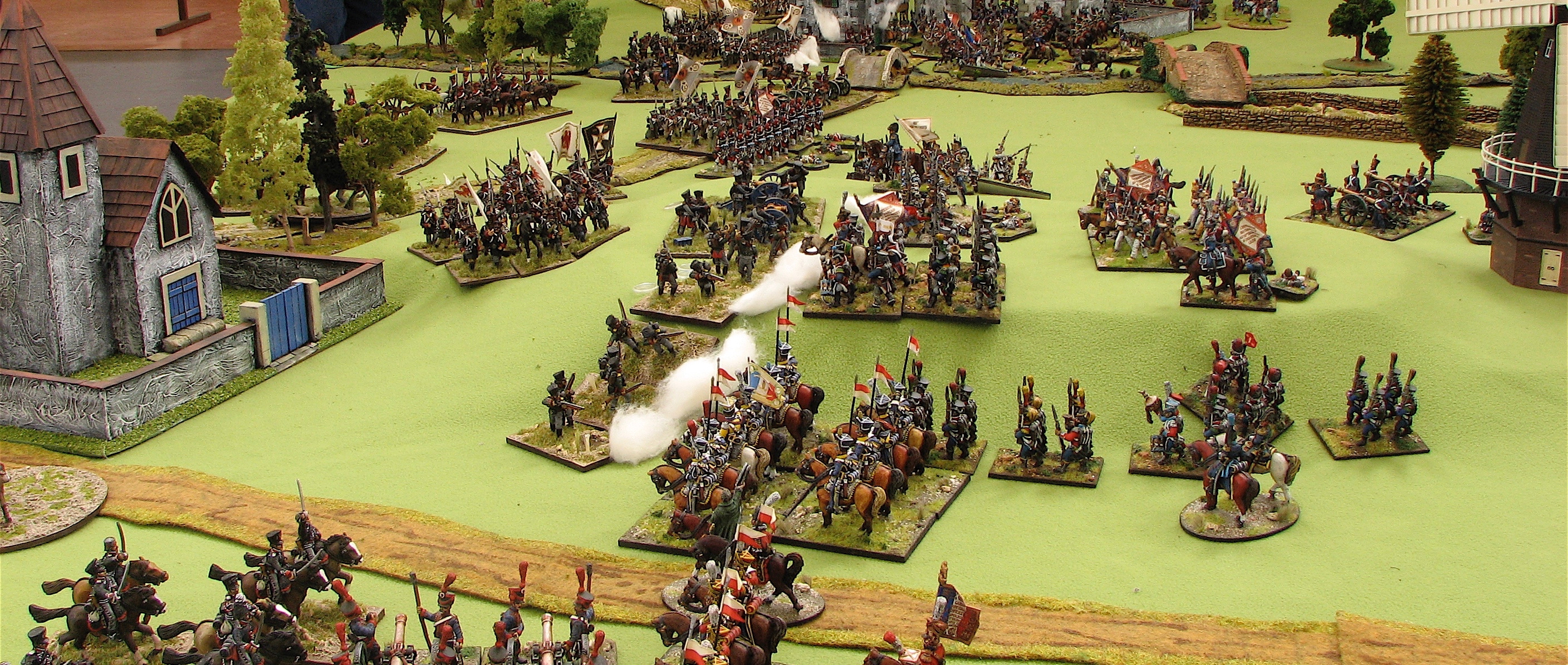
Napoleonic Memoire: Battle of Biburg
Played: Sunday 12 August 2007
Rules: General de Brigade
Call to Arms (CtA) is the annual wargames convention hosted by the Wellington Warlords here in Wellington, New Zealand. Over the years our loose grouping of gamers then known as the Kapiti Fusiliers have supported CtA, usually via the means of demonstration games. In the main competition games are not our style as we prefer a more leisurely and social approach to our gaming. The result be damned ... especially should it go against us! it’s the playing, the spectacle, the snatched moments of glory that count!! OK, that’s a little over the top. We like to win, but it’s not an obsession.
Call to Arms 2007 timing was auspicious in that it coincided with the culminating battle of a trial campaign six of us had been involved in. It was loosely based on the 1809 campaign around Ratisbon and was imaginatively entitled The Ratisbon Campaign, or just Ratisbon for short. Rhys Jones organised the campaign primarily as a game generator and worked wonders creating a node based campaign map and maps for each of the nodes. These node maps were based on battles through history with terrrain features renamed. Some preliminary battles were fought as entrees but now all armies were either present on Node 4, the town of Biburg and surrounds, or due to arrive shortly to partake of the main course!
Ensconced on the field were two allied armies. A Russian army lead by the wily Generallieutenant (GL) Gregorovitch (Greg Simmonds) who had already survived an encounter against two French armies at Segensburg and a Russo-Prussian army under the command of Generalmajor (GM) von Peter himself. Fate had (not?!) been kind to GM von Peter himself who found himself far removed from the initial battles of the campaign and unable to intervene in them. Action was here at long last ... gulp!
The two allied armies arrayed themselves from in front of French held Kutt-Schutten in the east through to Biburg, where their lines joined, and then angled back in a north westerly direction in front of Althof.
Biburg is the major local population centre and as such was assigned two town zones. The two allied commanders held a council of war and decided that each army would occupy one of the zones of Biburg as their extreme flank - thus making Biburg the hinge of their joint deployment. Well that was the outcome of the council of war that GM von Peter himself attended! GL Gregorovitch’s council of war had GM von Peter himself occupying all of Biburg. You can probably see where this is going. The difficulties inherent with allied forces working cooperatively was fully, if unintentionally, modelled in the game. Quite clever really!! With great insight GM von Peter himself blames the language difficulties, particularly on the Russian side ... but he would wouldn’t he!
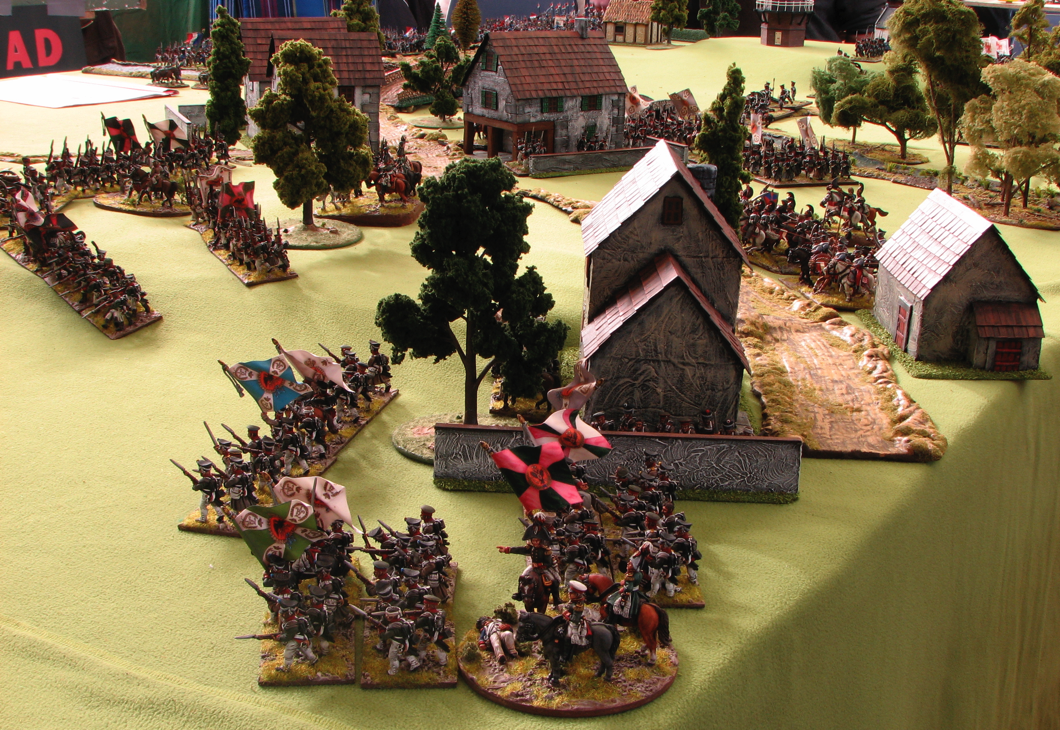
Above: GL Gregorovitch’s Russians form up with their right resting on Biburg (in the distance) ... but not actually in the near half of Biburg.
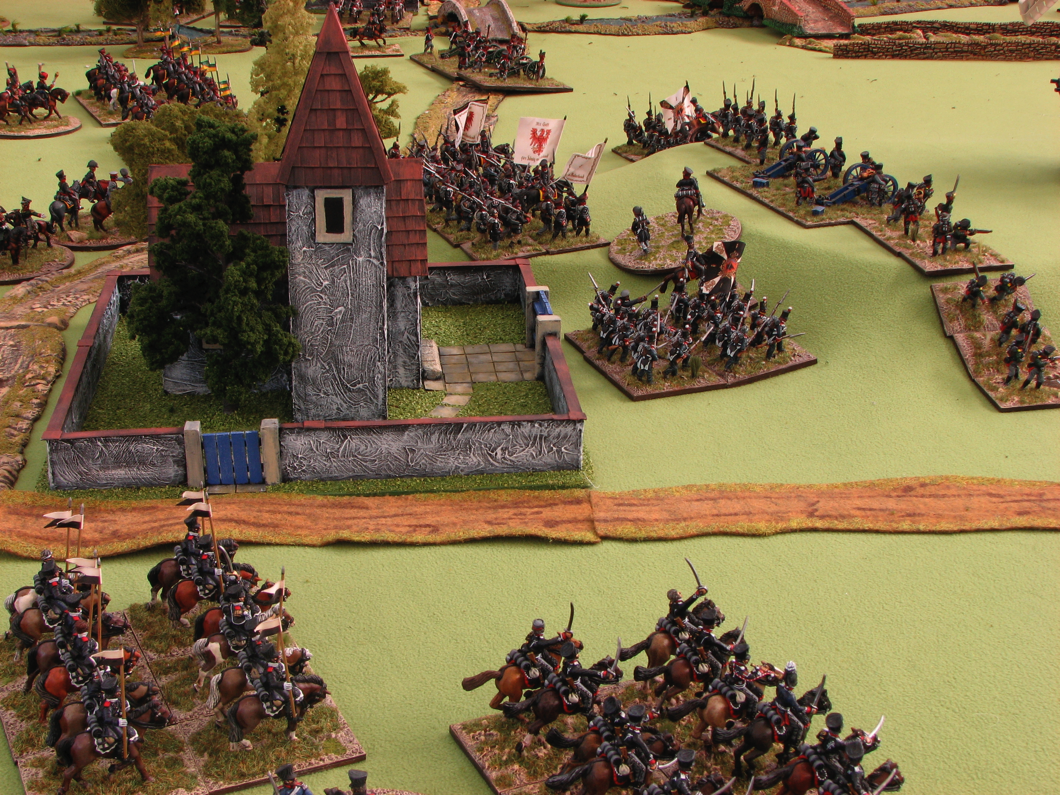
Above: GM von Peter’s Prussians clustered around Althof and holding the extreme right flank for the allied cause.
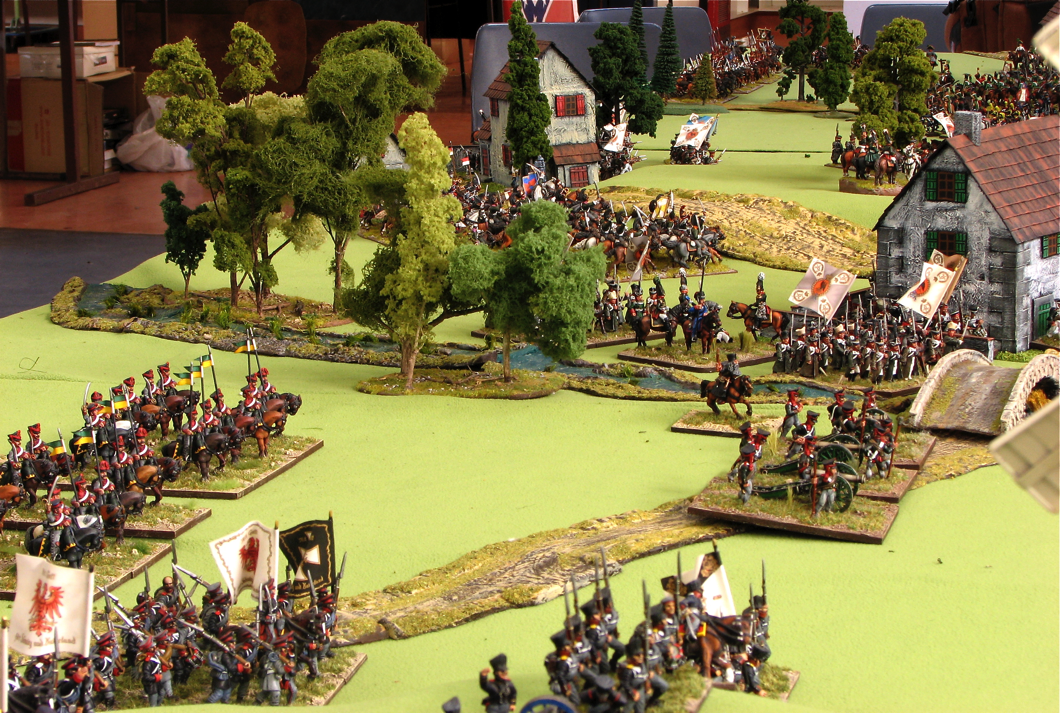
Above: GM von Peter’s Russians extend the line from his Prussians through to Biburg and the Russian army of GL Gregorovitch. The Inn just over the Abens River has been garrisoned by a battalion of GM von Peter’s Russians ... but what about the other portion of Biburg (just out of the shot)?
Two French armies had followed GL Gregorovitch to the environs of Biburg. Their commanders were Generals de Division (GD) Hermanelle - Roly Hermans - and Jonesallette - Rhys Jones - who was ably assisted by General de Brigade (GB) Daniel his son and military protege. Unfortunately for them the roads they were travelling along did not have the capacity to have both armies completely present as the battle commenced. Most of GD Jonesallette’s army was to arrive during the game.
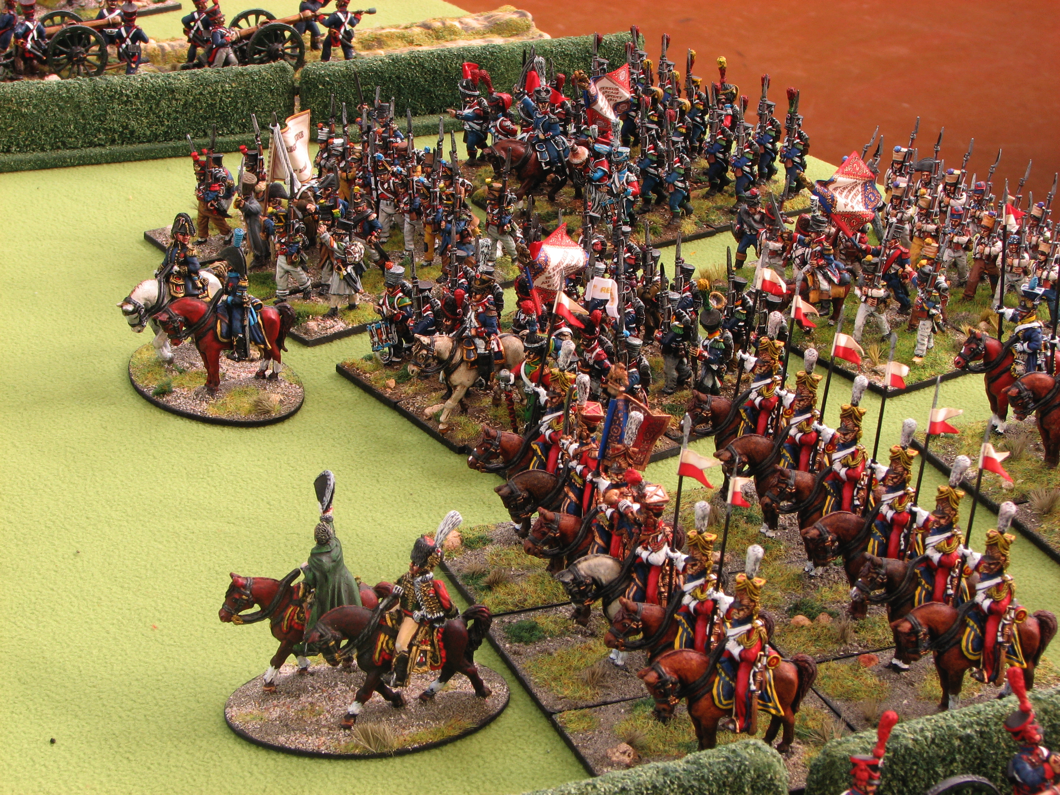
Above: Part of GD Hermanelle’s French force of intended occupation. I don’t think they’ve come with peaceful intent!
GD Hermanelle held the left flank of the French line opposing GM von Peter himself.
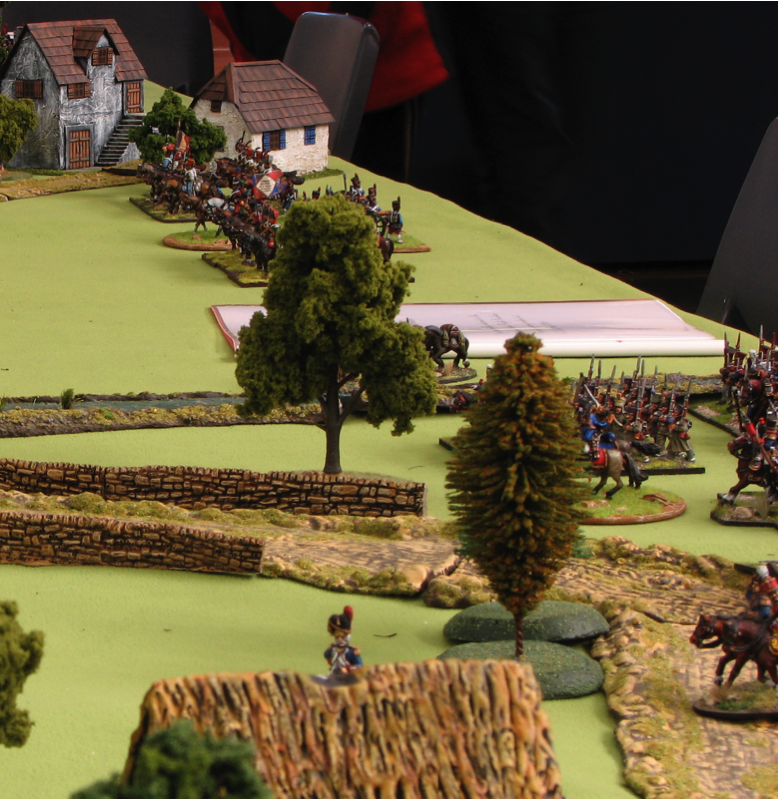
Above: GD Jonesallette’s meagre forces as the battle commenced. Fortunately / unfortunately - it all depends on where your sympathies lie - his force was to grow as the French sorted out their traffic woes on the road from Segensburg.
A third French army, that of General de Division (GD) St. Swaintonne - Terry Swain - was also present. He had slipped his army past a blocking allied army at the Battle of Rohr and was now in possession of the village of Kutt-Schutten on the left flank of the allied line. A slight distraction for him was the allied Austrian army of Feldmarschal-leutnant (FL) Hollowarthier - Alan Hollows - which was likely to arrive on the road from Rohr placing the French of GD Swaintonne between the emplaced Russians of GL Gregorovitch and the arriving Austrians. With only a slight quiver in his voice the brave GD St. Swaintonne announced his intention to hold his position and keep the allied armies apart! If the remainder of GD Jonesallette’s forces arrived before the Austrians all might yet turn out well!
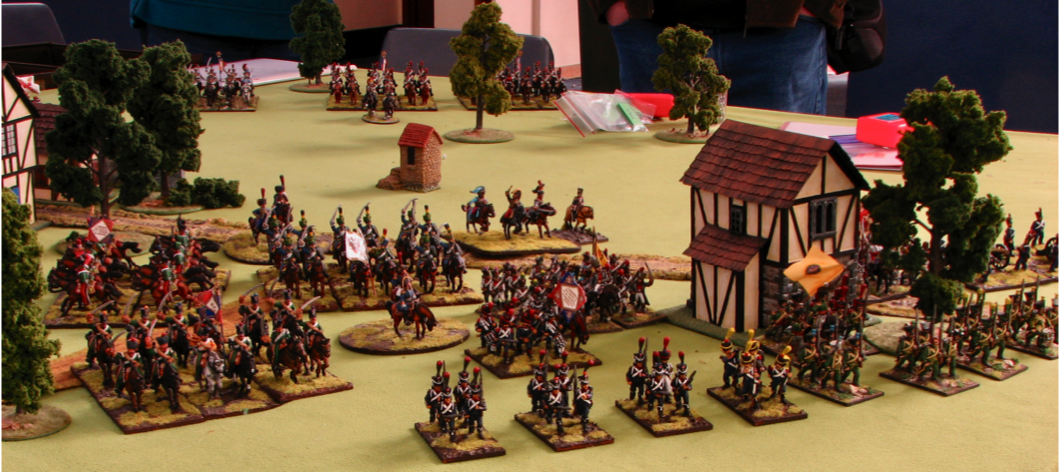
Above: Part of GD St. Swaintonne’s forces. The rest of his army is out of shot and facing the other way! He was positioned on the flank of GL Gregorovitch ... which was good for him. But he had been followed along the road from Rohr by the Austrians of FL Hollowarthier which could appear at any time behind him potentially creating a French sandwich ... which would be bad for him.
Note the Austrian hussars masquerading as French cavalry for this game.
An interesting aside time. Node 4, the town of Biburg and surrounds, on the campaign map was based on the Battle of Eylau (1807) and it is interesting how our purely fictitious battle mirrored that real life battle. In our campaign GD St. Swaintonne marched onto Node 4 (as did the Prussian General Lecoq in 1807) followed by the pursuing FL Hollowarthier (as did Ney in 1807).
Rules, figures and assorted practical things
The game was played using the General de Brigade ruleset which we are still getting to grips with. We did not use the normal 1:20 figure ratio or 1:2 cannon ratio as set down by the rules though. Our battalions are mostly 24ish figures strong so closer to a 1:33 figure ratio and batteries of 2 cannon or sometimes 3 for those large 12 gun Russian batteries. There are some anomalies, but the games seem to work.
Figures used were of the 28mm variety from a selection of manufacturers. Front Rank Figurines provide the lions share of the figures and Calpe all the Prussians. Some of the Russians and French are from Foundry Miniatures Ltd, and yet more of the French from Old Glory and Companion Miniatures. I’ve probably left off a manufacturer or two. Sorry.
The game was played on a 16 by 6 foot table. Most of the buildings placed upon it were custom built by Rhys Jones, accompanied by a Hovels Le Belle Alliance and perhaps a Hovels bridge care of Roly Hermans. The river, much of the roading and a bridge came from Miniature World Maker across the Tasman Sea in Australia. They are made from a rubber compound and come pre painted, flocked etc. Trees were an assortment of the commercial and Greg or Rhys bespoke herbage efforts.
The individual armies started the campaign at 1000 points using the points system contained in General de Brigade. Any units lost through routing or total destruction in a campaign game were permanently lost to the campaign, and hence were not present at this battle. All surviving units of a campaign game were returned to full strength for the succeeding campaign game. 1000 points does not allow for large armies, especially when leaders must be paid for as well, which worked out well for us overall. It did mean that several favourite troops had to be left out of army lists as room could not be found for them. This was especially true for the heavy cavalry. Some armies were modelled around the 1809 campaign, others on the 1813 campaign. In the end this didn’t matter as the points system ensured a higher quality force was smaller than one of lower quality.
If you look closely you may spot an Austrian hussar and an Austrian battery masquerading as French. Also the French had a battalion or two of Spanish allies. Other than that we managed to field the armies with the correct models. Hurrah!
So - what happened?
With six players (once they were all on the table), rule clarifications, many discussions with passers by, a more social approach to the game and a von Peter himself who had a focus on only one portion of the battlefield I won’t even try to give a complete narrative of the Battle of Biburg. Rather I will give a brief overview of the whole affair and focus on some of the more glorious &/or interesting events. Perhaps the pictures will tell some of the story as well.
Battle in the west
The battle for the village of Althof. On the western reaches of the battle GD Hermanelle came at GM von Peter himself with a disturbing alacrity! His cavalry was quick to assert its superiority with the guard class Dutch Lancers handling the elite Leib Hussars roughly and forcing this proud unit to the back corner of the battlefield but, crucially, not off it. The elite Vistula Lancers then made short work of the 2nd Pommeranian Landwehr cavalry routing them out of the game. So much for the cavalry cover for GM von Peter himself! But worse, this freed up the attached horse artillery to come up and unlimber close to the Prussian infantry. We shall return to these lancers and this blasted/blasting battery a little later.
A little further east a solid mass of infantry in French blue had advanced on the Prussian first infantry line and after a short exchange of fire four (or maybe only three!) battalions charged a brave Prussian musketeer battalion (1/3rd East Prussian) and the 6 pounder foot battery von Glasnapp. The second line of infantry was readied to stave off this mass but they weren’t needed ... yet! ... as all the chargers ‘Faltered’ and failed to charge home. Hurrah for the King and the Fatherland!
To rub salt into the French wounds a battalion - half of a large Russian hussar regiment - of the Russian Elizabethgrad Hussars managed to cunningly charge out of the allied lines to catch a French battalion before it could form square. One less battalion for the allies to worry about and the hussars managed to return safely behind friendly lines. A round of vodka for the brave hussars.
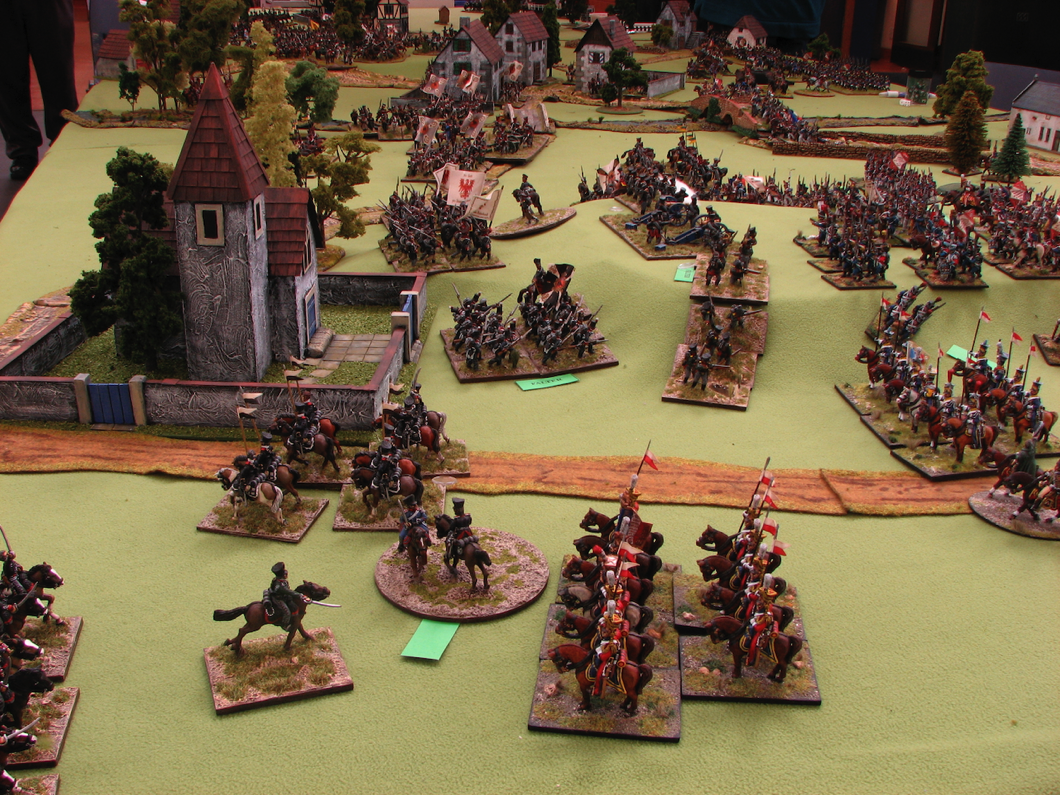
Above: The situation looking east at the end of the narrative above.
At the bottom centre of the photo are the red and white lance pennons of the Dutch Lancers having just beaten the Leib hussars just visible bottom left. The Vistula Lancers (the other red & white pennons) in blue uniforms have just seen off the Landwehr cavalry (black & white pennons next to the church yard), the routing of which has resulted in morale tests and faltered the two infantry battalions to the east (the green labels by each battalion have the word ‘Falter’ on them).
Several green ‘Falter’ labels can be seen behind French infantry units on and east of the hill as a result of the Elizabethgrad Hussars charge. Immediately beyond the hill the Elizabethgrad Hussars can just be seen with the front rank having green and yellow pennons. The routing remainder of the battalion they attacked is obscured by the two trees.
Now is as good a time as any to heap praise on one of GD Hermanelle’s line battalions ... even though it hurts to do so! Graded as ‘2nd line’ this unit soaked up all the punishment the Prussian 6 pdr foot battery dished out. They died in droves but stood like guardsmen. At the end of the day they were at less than half strength and still standing. Their last act of the battle was to fire an understandably weak shot at the the battery which resulted in a double 6. For those unfamiliar with the General de Brigade rules double 6’s invariably mean bad things for the the unit being double 6’ed. The battery automatically Faltered.
Back to the French lancers and horse battery. The Dutch Lancers again charged the now reformed Leib Hussars looking to administer the coup de grace but were pushed back, and for the ongoing melees they had now lost the advantage of the charging lance. They were to be pushed back several more times and at games end, though still back peddling, they refused to break. Of great relief to the Prussians this swirling cavalry melee swirled over and through the damaging French horse battery which had already dismantled one Prussian battalion with it’s fire. I have a suspicion that we played the over running of the battery wrong, but it seemed right at the time ... honest!
GD Hermanelle had managed to get two of his battalions to reform and charge the 1/3rd East Prussian again, this time with success. Another fresh battalion also forced back a Russian battalion at the point of the bayonet. The scales were tipping the French way in the infantry fight. Could the battered Allied second line hold the French? Would the foot battery finally free itself of the cursed battalion to it’s front and lend it’s badly needed weight elsewhere? Would the covering hussars be able to thread their way through the wreckage to get at the unformed French battalions in time? Would a failed Unit Morale Test ripple through several units or lead to a failed Brigade Morale Test? All questions that will now never be answered!
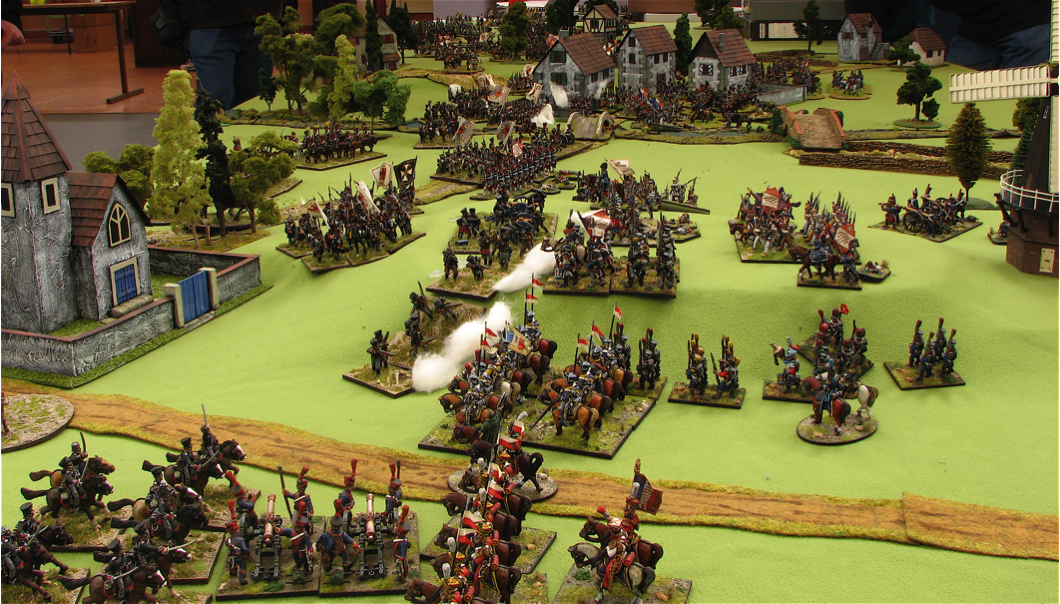
Above: The battle in the west at games end.
The Leib Hussars have pushed the Dutch Lancers back through the French Horse Artillery which has got caught up in the melee to the great relief of the Prussians!
Note the empty patch of land between the church yard and the firing front line Prussian unit. This ground recently vacated by a Prussian reserve battalion which was pounded by the infernal horse artillery.
Battle in the east
The battle for Kutt-Schutten ... or can the forces of good make a French sandwich?
The central portion of the battle was the last to see any major action because of the time it took the French forces to get onto and across the table. The eastern theatre was different as the French under GD St. Swaintonne and the Russians of GL Gregorovitch started quite close to one another. So it is to the east that our attention now turns.
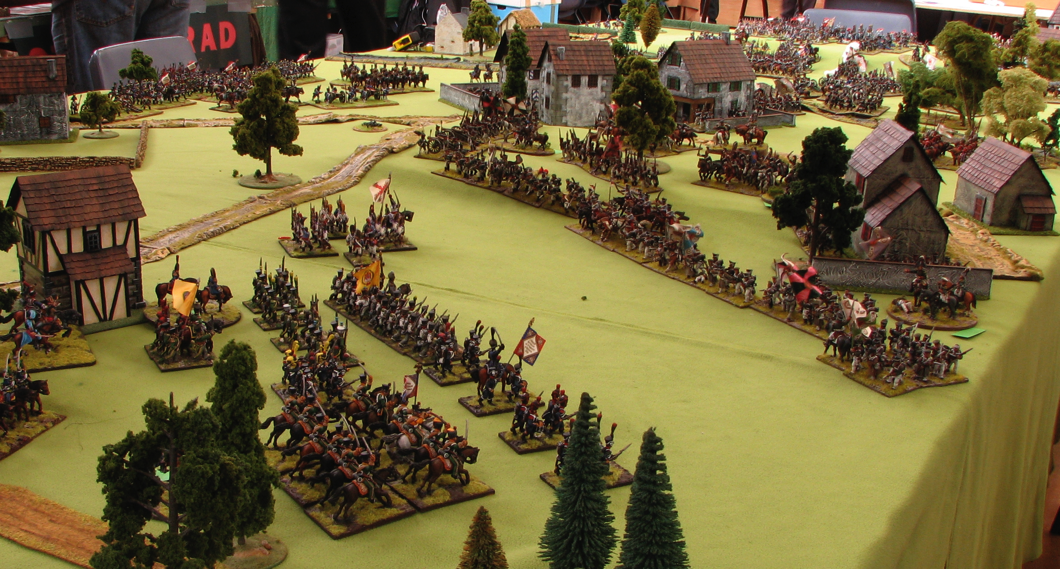
Above: The scene in the east a little into the game.
Can GD St. Swaintonne distract enough Russians for long enough before the delayed French centre makes it’s presence felt?
Despite orders to pull back from his position of great danger GD St. Swaintonne determined to stay where he was on the flank of the Russians even though the Austrians of FL Hollowarthier could arrive at any time ... to his rear!
Early on the skirmishing 1/15th legere of GD St. Swaintonne managed to cause casualties on the Russians, including wounding a brigade commander via one of those double 6 things, before being forced back. The 1/15th legere was seeing battle for the first time and managed to acquit itself honourably unlike the usual performance of such newbie units who tend to break for the rear at the slightest inducement.
When the Austrians did finally arrive in force they mounted a serious attack on the village of Kutt-Schutten in an effort to unhinge and cause maximum embarrassment to the French. Three battalions of the white coated Austrian infantry stormed forwards. What could the outnumbered French possibly do? Leading from the front the grizzled veteran GD St. Swaintonne promptly threw a double 6 which automatically faltered all three Austrian battalions. A true master of timing, the art of war and some might say the dark arts!
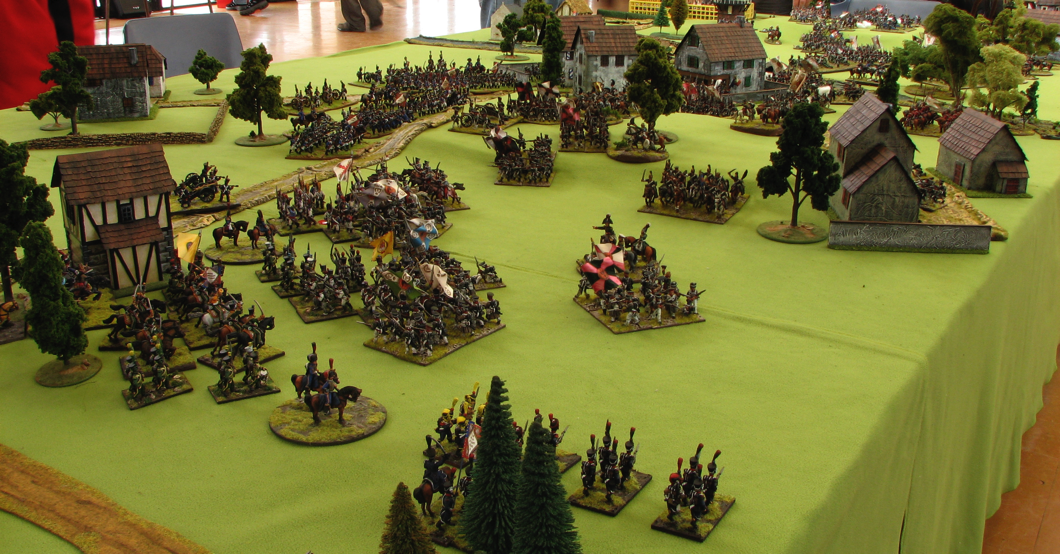
Above: The scene in the east at the end of the game.
The Russians have formed an avalanche of aggressive attack columns bristling with bayonets ... their weapon of choice. Will the French sacrifices here be enough of a distraction to enable the French centre to win the battle?
Despite such masterful martial maneuvers the pressure continued to build on on GD St. Swaintonne’s command. The Russians were pressing hard and managed to break two of his squares, with the Isum Hussars taking part in the breaking of one in their first battle. The Austrians were also readying themselves for something spectacular. “Give me GD Jonesallette or give me night” may have been a fitting utterance from GD St. Swaintonne.
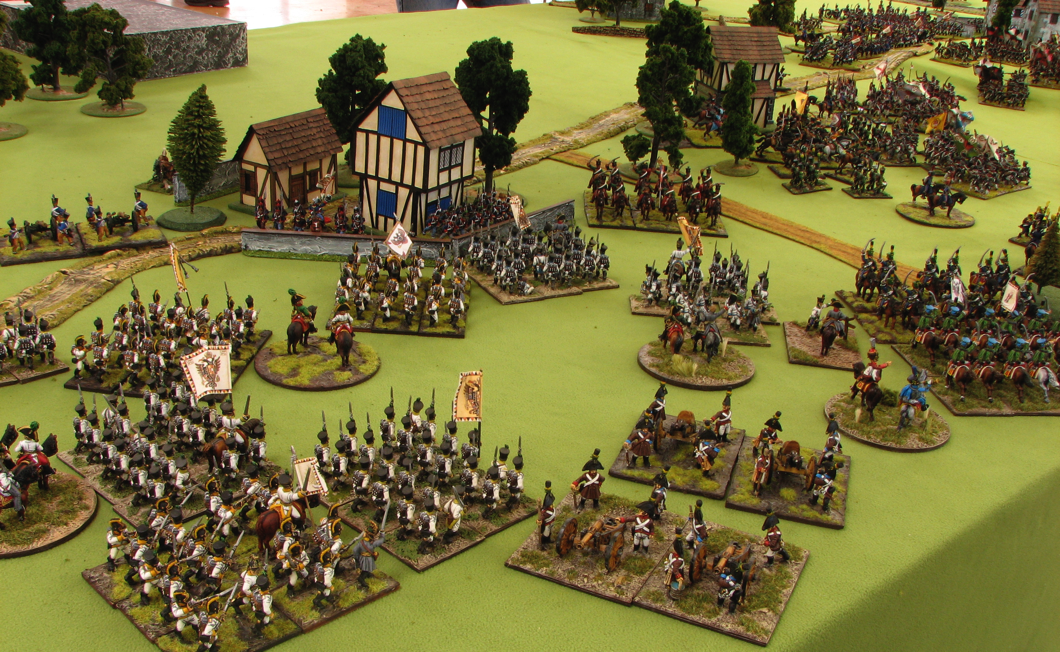
Above: The scene just to the east of the Russian avalanche at the end of the game.
The Austrians of FL Hollowarthier give GD St. Swaintonne reason to check over his shoulder! Perhaps the village defenders can throw another miracle double 6!!
Meanwhile ... the goings on in the centre
This was the central battle around and for the town of Biburg itself.
As already reported the battle in this sector did not start auspiciously for the allies with half of Biburg left without a garrison due to a misunderstanding at the highest levels of the allied command. The fighting in the centre did not commence until well after that to the west and east. Much of GD Jonesallette’s French were not on the table as the battle commenced due to congestion on the single road from Segensburg along which two French armies advanced. In fact several turns passed before the bulk of GD Jonesallette’s French even appeared.
The town of Biburg formed the hinge between GL Gregorovitch’s Russians and the Russo-Prussians of GM von Peter himself Russo-Prussians and these worthy individuals had their focus fixed elsewhere. It should have been a fortress protecting that hinge. GL Gregorovitch was attempting to eradicate the French to the east and GM von Peter himself had his hands full to the west so it came as a bit of a rude surprise when the cheeky French just sauntered into the unoccupied part of Biburg!
GL Gregorovitch - “The French have just taken a bit of your Biburg”.
GM von Peter himself - “ Not mine. My bit has got a battalion holding it. That’s your bit”.
GL Gregorovitch - “But you’re meant to be holding Biburg”.
GM von Peter himself - “No. We were each meant to hold the section on our side of the town”.
Oh how we - and the French - laughed. The conversation didn’t go on much more than that as the two worthy individuals had plenty to do and turned back to their work. GL Gregorovitch back to the east and GM von Peter himself to the west.
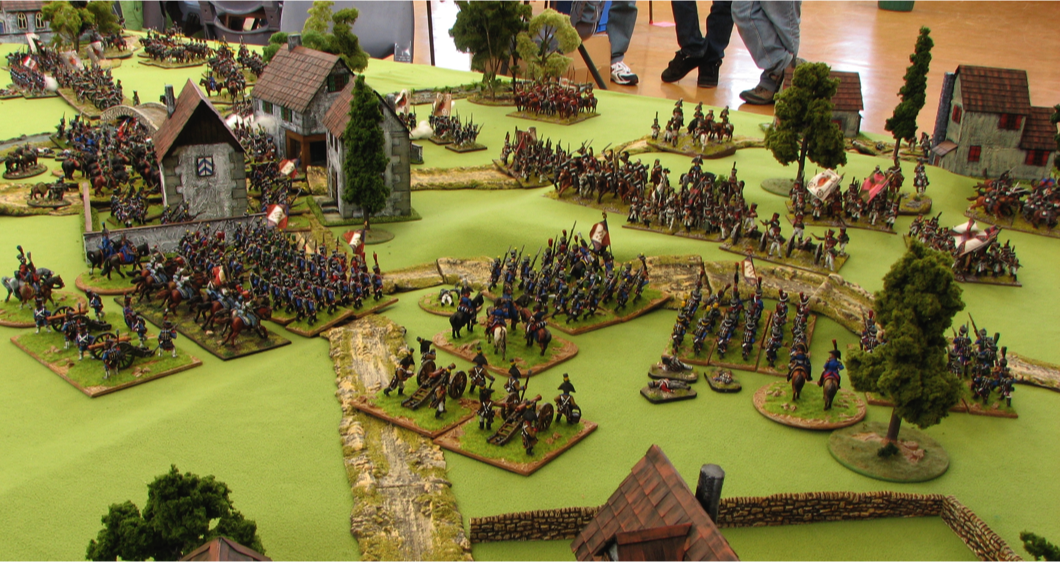
Above: The big French push in the centre about to come to the big crunch. Will the French élan carry the day or will the dogged Russian resistance prevail? Send your answers and $20 to von Peter himself! 😃
Oh, and for the sharp eyed that Austrian battery is really a French battery for game purposes for any concerned Francophiles out there.
The fall of half of Biburg had consequences for the allies that were not slow to arrive. With no units in a position to immediately contest the lost part of Biburg the French felt secure enough to quickly attack the rest of Biburg with two battalions. These weathered the defensive fire from two Russian battalions of GM von Peter himself and then had the effrontery to throw a double 6 in the melee to see the Russian garrison evicted with double casualties.
GM von Peter himself threw a Russian jager battalion - specially prepared in advance for this sort of eventuality - at the new and still unformed residents of Biburg, but the resulting melee was a draw so the hoped for immediate exchange of residents did not occur.
It was then realised that the French battalion holding the disputed real estate was a battalion of the International Fusiliers. Two battalions of French and a command stand were painted by various Friday Night Fusiliers from around the world. See Accounts of international co-operation from the archives for more details on this formation.
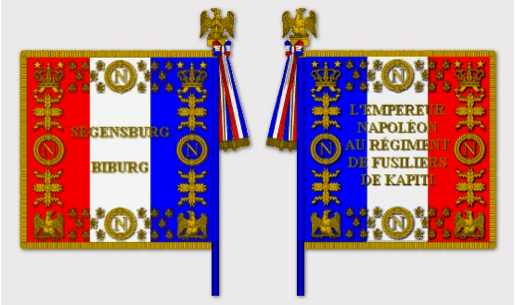
Above: The standard of the International Fusiliers displaying two honours, both earned in this campaign. Segensburg for victory over a Russian battalion and Biburg for taking and holding the town of Biburg in this battle of the same name. Nice artwork by Roly Hermans.
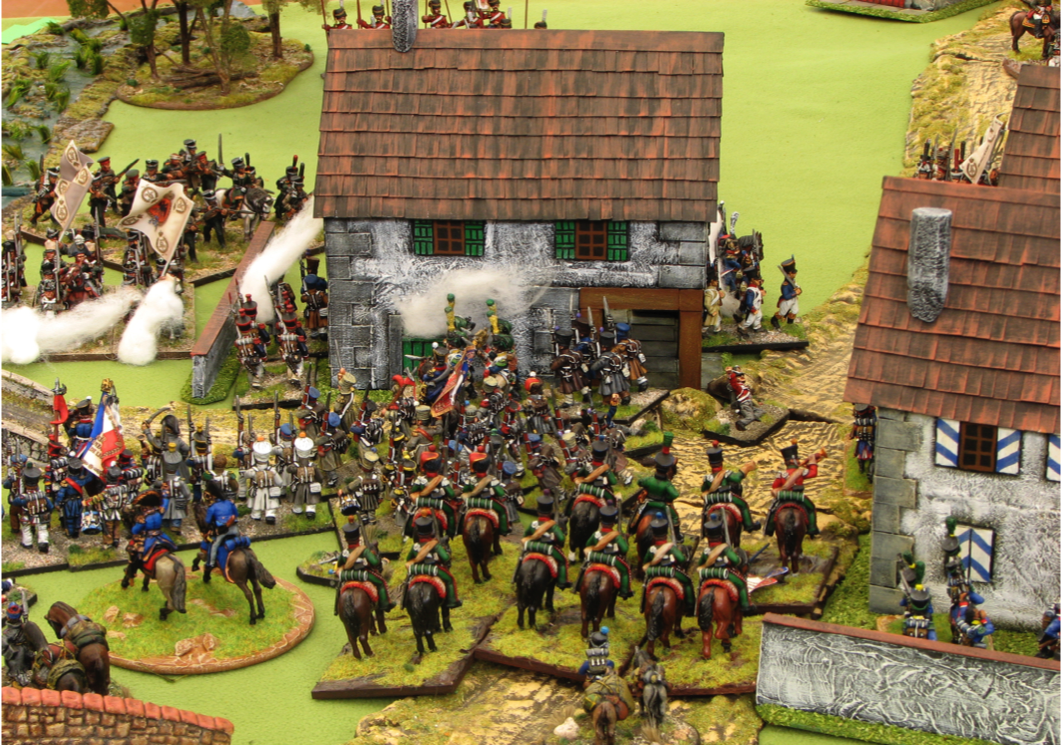
Above: The French claim the remainder of Biburg and will hold it against a counter attack by the closest of margins. The honours fall to a battalion of the International Fusilier battalion.
Time ran out for GD Jonesallette’s big push to the immediate east of Biburg in the centre of the battle. This would have been interesting as he had the weight of numbers but had to go uphill versus Russian grenadiers, a battery and the only heavy cavalry in the battle.
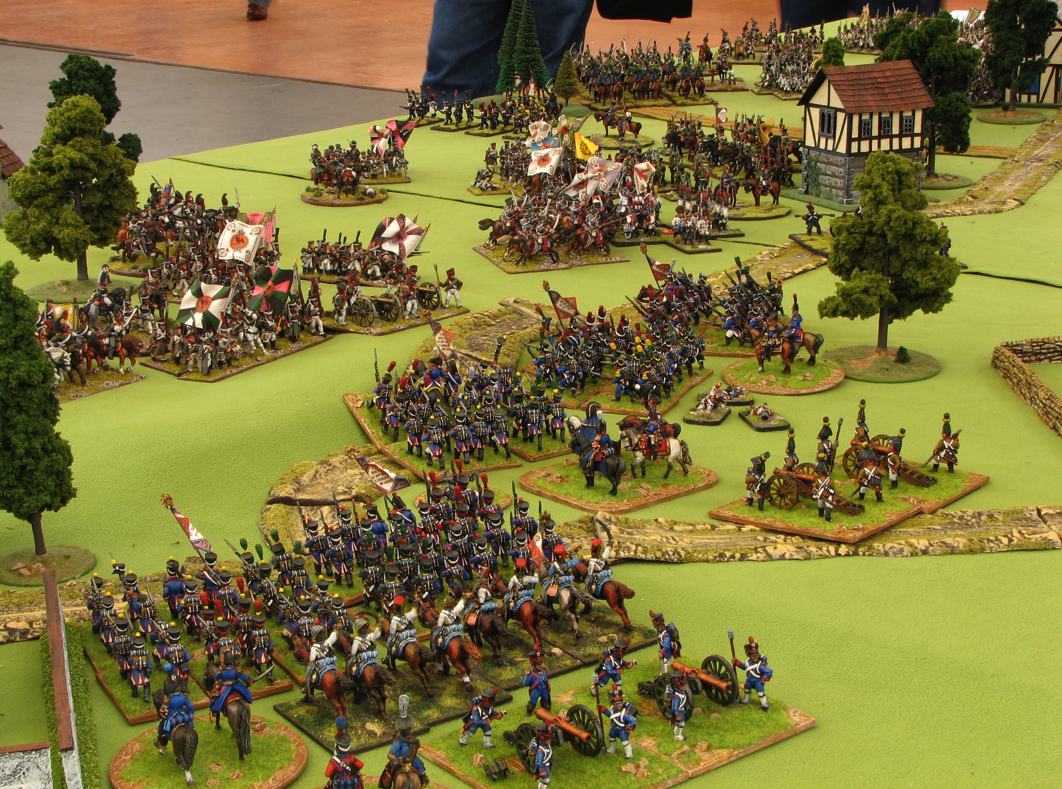
Above: The eastern half of the battle with that French battery dressed as Austrians again. When will the local Frenchies sort out their armies?!
Thoughts
Brilliant! I really enjoyed myself playing, chatting to various people ... and looking up the effects of the four or five double 6’s thrown against me! These cost me faltered units, double casualties, a dead ADC and two wounded brigade commanders. In addition GD St. Swaintonne proudly announced that he threw three of the dastardly double 6’s. I don’t think the allies threw any? What was it with the dice that fateful day? Were they all French sympathisers?!
The game looked fairly spectacular as was attested by various passers by - and ourselves! - and this was one of our aims when presenting the game. This was after all the only Napoleonic game played at the convention and needed to make a statement.
The size of the game was about right I felt. Another hour or so would have answered a few of the open questions, but the aim was not so much to complete the game as to put on a good show, learn the rules a little more, have a social day, and above all to enjoy ourselves. I think we succeeded.
Most of us went to a Cafe after the game for some well earned caffeine. It seems that I was not alone in my enjoyment of the day and many ideas flew on what we can do in the future. Nothing like a good game to get the hobby juices percolating again.
Salute
von Peter himself